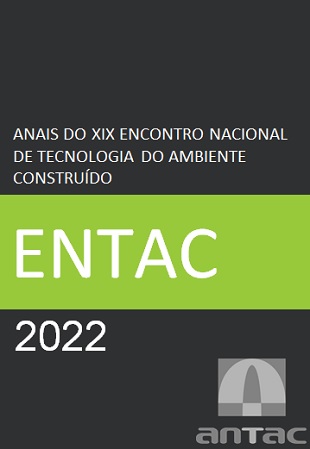Mudanças no comportamento de caminhada durante a pandemia de COVID-19 no Brasil
DOI:
https://doi.org/10.46421/entac.v19i1.2022Palavras-chave:
Deslocamento ativo, Caminhada, Pandemia, COVID19Resumo
Evidências indicam que as características do ambiente construído podem estimular a atividade física, promovendo melhora na saúde. Devido à alta transmissibilidade do vírus SARS-CoV-2, diversos países implementaram medidas restritivas de circulação. O objetivo do estudo foi analisar mudanças no comportamento de caminhada antes e durante a pandemia no contexto brasileiro. A partir da aplicação de questionário em plataforma webGIS na cidade de Londrina-PR, identificou-se um aumento expressivo de viagens a pé para realização de atividade física na amostra (n=305). Os resultados subsidiam discussões de políticas públicas urbanas de cidades mais saudáveis e resilientes, um dos 17 Objetivos do Desenvolvimento Sustentável.
Referências
D. Adlakha and J. F. Sallis, “Activity-friendly neighbourhoods can benefit non- communicable and infectious diseases,” Cities Heal., no. Special Issue: COVID-19, pp. 1–5, 2020.
M. U. G. Kraemer et al., “The effect of human mobility and control measures on the COVID-19 epidemic in China,” Science (80-. )., vol. 368, no. 6490, pp. 493–497, 2020.
H. Frumkin, “COVID-19, the built environment, and health,” Environ. Health Perspect., vol. 129, no. 7, pp. 1–14, 2021.
A. Sahasranaman and H. J. Jensen, “Spread of COVID-19 in urban neighbourhoods and slums of the developing world: Spread of COVID-19 in urban neighbourhoods and slums of the developing world,” J. R. Soc. Interface, vol. 18, no. 174, 2021.
K. Wunsch, K. Kienberger, and C. Niessner, “Changes in Physical Activity Patterns Due to the COVID-19 Pandemic: A Systematic Review and Meta-Analysis,” Int. J. Environ. Res. Public Health, vol. 19, no. 4, 2022.
S. P. Obuchi, H. Kawai, M. Ejiri, K. Ito, and K. Murakawa, “Change in outdoor walking behavior during the coronavirus disease pandemic in Japan: A longitudinal study,” Gait Posture, vol. 0, no. January, pp. 42–46, 2021.
C. Ekpanyaskul and C. Padungtod, “Occupational Health Problems and Lifestyle Changes Among Novice Working-From-Home Workers Amid the COVID-19 Pandemic,” Saf. Health Work, vol. 12, no. 3, pp. 384–389, 2021.
P. Z. Siegel, R. M. Brackbill, and G. W. Heath, “The epidemiology of walking for exercise: Implications for promoting activity among sedentary groups,” Am. J. Public Health, vol. 85, no. 5, pp. 706–710, 1995.
A. Z. Dalgallo, A. L. F. Leão, and M. Kanashiro, “Datos de la caminata usando webGIS,” Rev. Latino-americana Ambient. Construído Sustentabilidade, vol. 2, no. 6, pp. 55–67, 2021.
B. Kang et al., “Differences in behavior, time, location, and built environment between objectively measured utilitarian and recreational walking,” Transportation Research Part D: Transport and Environment, vol. 57, pp. 185-194, 2017.
B. Giles-Corti et al., “What next? Expanding our view of city planning and global health, and implementing and monitoring evidence- informed policy,” Lancet Glob. Heal., 2022.
IBGE, “Panorama municipal: Londrina-Paraná,” 2010. [Online]. Available: https://cidades.ibge.gov.br/brasil/pr/londrina/panorama. [Accessed: 13-Jun-2022].
IPPUL (NSTITUTO DE PESQUISA E PLANEJAMENTO URBANO DE LONDRINA), “IPPUL Downloads,” Sistema de Informação Geográfica de Londrina (SIGLON), 2022. [Online]. Available: https://portal.londrina.pr.gov.br/downloads-siglon.
A. L. F. Leão, “Objective walkability measures for Brazilian towns: a methodological approach,” Universidade Estadual de Londrina, 2019.
B. E. Saelens, J. F. Sallis, J. B. Black, and D. Chen, “Neighborhood-based differences in physical activity: An environment scale evaluation,” Am. J. Public Health, vol. 93, no. 9, pp. 1552–1558, 2003.
M. Abdullah, N. Ali, C. Dias, T. Campisi, and M. A. Javid, “Exploring the traveler’s intentions to use public transport during the covid-19 pandemic while complying with precautionary measures,” Appl. Sci., vol. 11, no. 8, 2021.
L. Budd and S. Ison, “Responsible Transport: A post-COVID agenda for transport policy and practice,” Transp. Res. Interdiscip. Perspect., vol. 6, p. 100151, 2020.
R. F. Hunter et al., “Effect of COVID-19 response policies on walking behavior in US cities,” Nat. Commun., vol. 12, no. 1, pp. 1–9, 2021.
A. Lotfata, A. G. Gemci, and B. Ferah, “The changing context of walking behavior: coping with the COVID-19 Pandemic in urban neighborhoods,” Archnet-IJAR Int. J. Archit. Res., vol. ahead-of-print, no. ahead-of-print, Jan. 2022.

